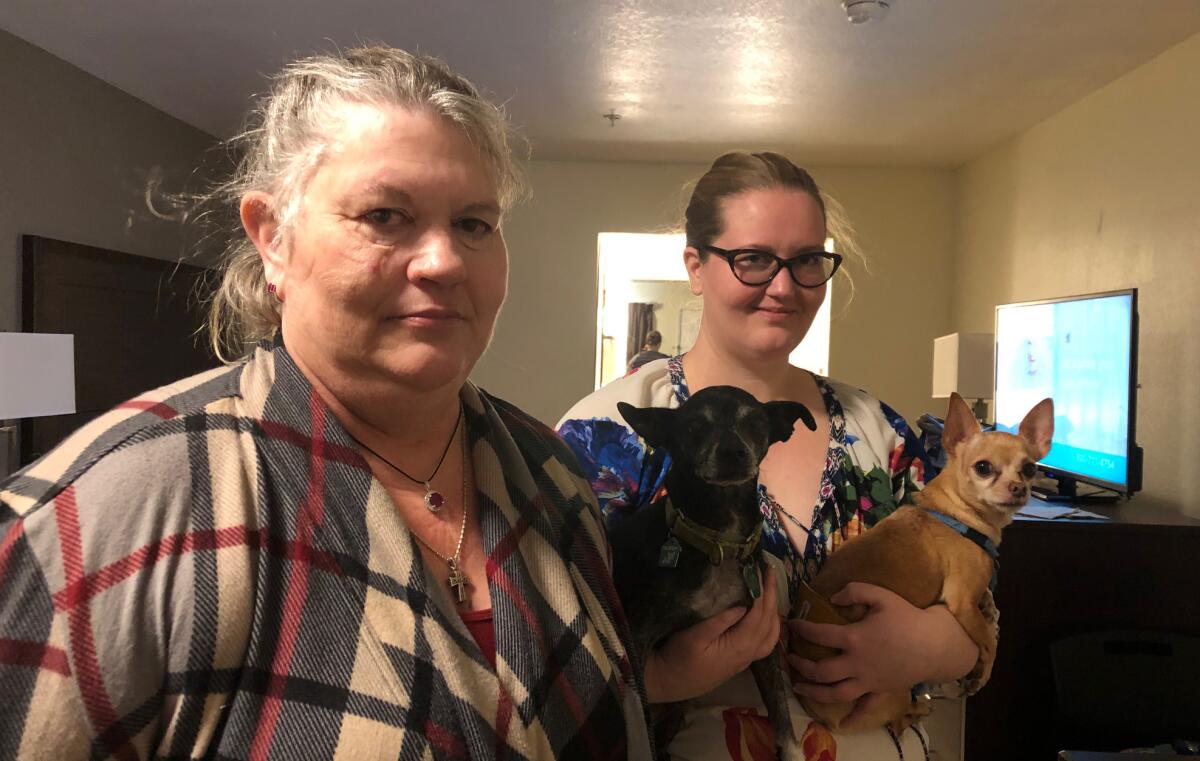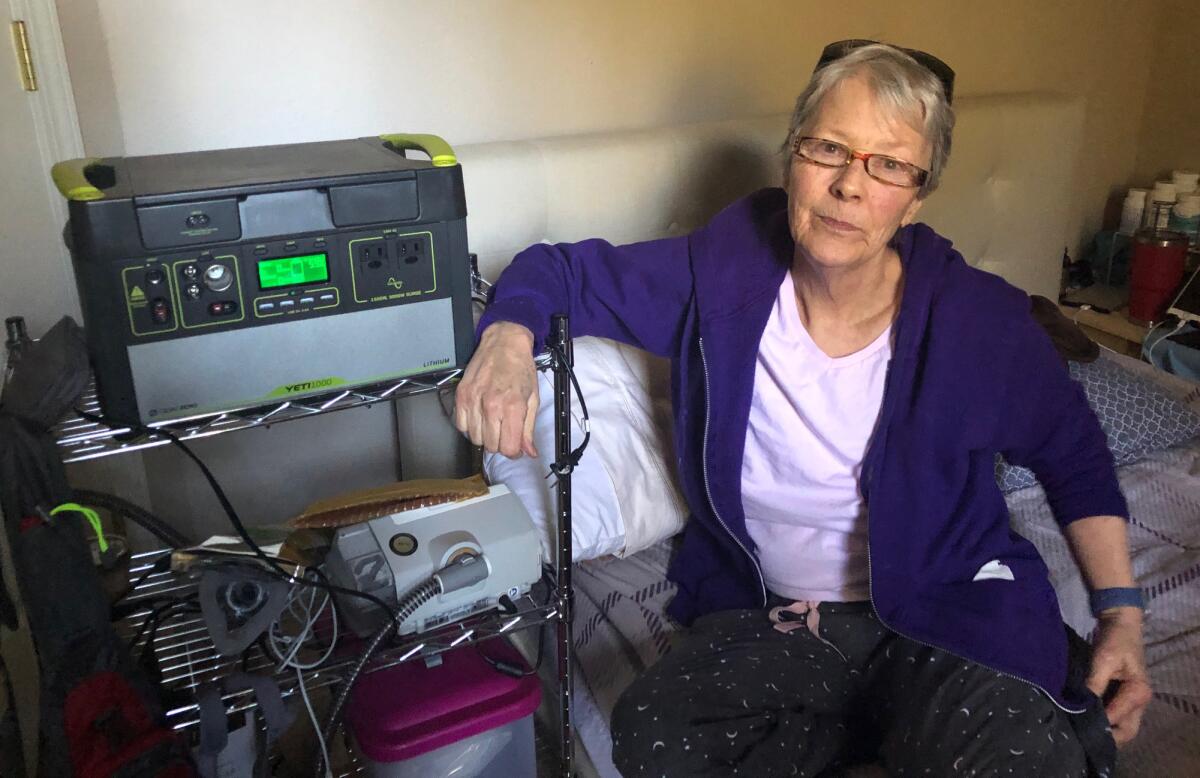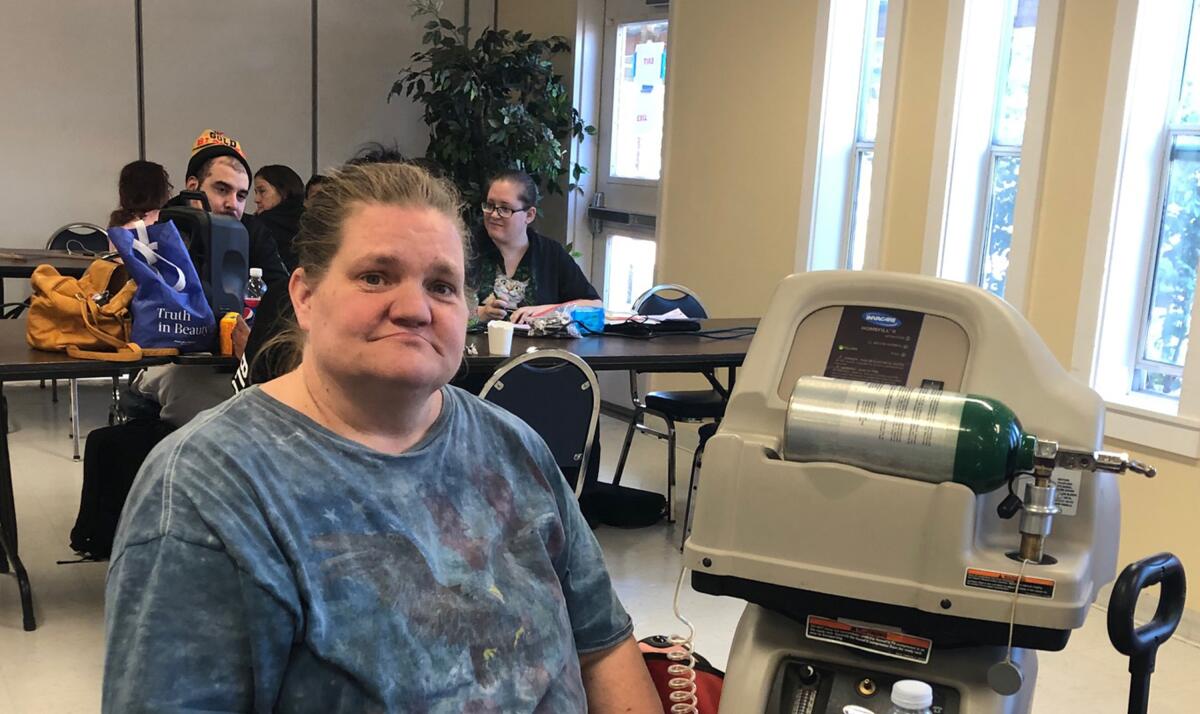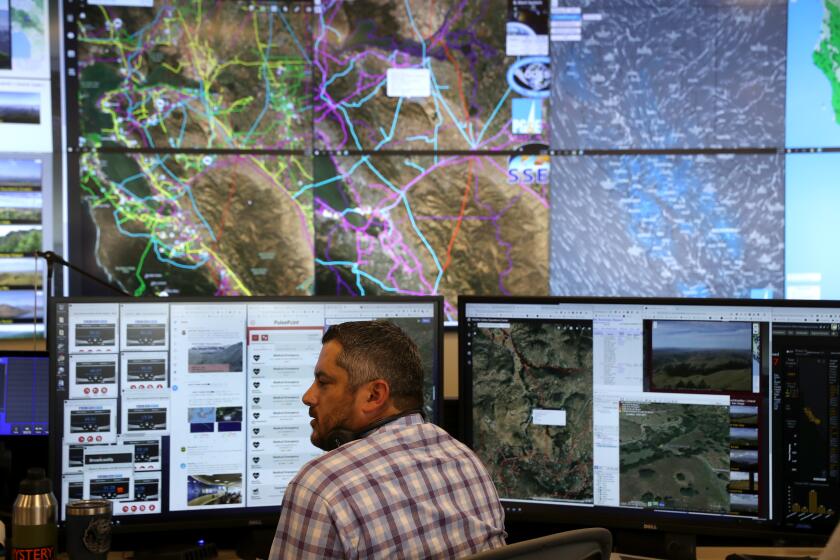PG&E power outages bring darkness, stress and debt to California’s poor and elderly

CLEARLAKE, Calif. — When PG&E cut power to her family’s remote Northern California ranch just after midnight Tuesday, Brenna Delwisch fought to stay awake.
She was afraid that if she slept, her mom would die.
A few years ago, her mother, Michele Newton, had a stroke and an aortic dissection, a rupture of heart arteries that can be fatal. Ever since, Newton has been afflicted with severe sleep apnea. At night she wears a continuous positive airway pressure (CPAP) machine, which keeps her breathing normally.
Without it, Delwisch said, “it’s like [her] chest is arguing with whether to breathe or not. It looks like a struggle.”
Delwisch, 33, watched that struggle, until she simply couldn’t stay awake any longer. Around 5 a.m., exhausted from anxiety, she gave up.
“I am not vigilant enough anymore,” she told Newton, a single mom who worked at gas stations and restaurants to raise her two kids. “You have to wake up.”
Delwisch and Newton are among the 65,000 people in Lake County, one of the most impoverished in the state, who are learning by trial what happens when utilities cut power to people living on the edge.
This week, as Pacific Gas & Electric Co. shut off electricity to hundreds of thousands to reduce wildfire risks, many Lake County residents discovered they weren’t ready, despite warnings that the cuts were coming. There were too many loose ends in their often complicated and precarious lives that hadn’t been accounted for by themselves or government agencies.
Some California utilities have developed systems to shut off power in targeted locations facing the worst wildfire risk. Pacific Gas & Electric is far behind, resulting in expansive outages.
Few understood what the challenges would be until they were in the dark: a mom who couldn’t refill her son’s medication for bipolar disorder; a man with schizophrenia who couldn’t quiet the voices in his head without the television on; the people on dialysis who had to travel to another town. In El Dorado County, just northeast of Sacramento, an elderly man died minutes after apparently losing power to his CPAP machine, according to a report from the local fire agency, though an autopsy listed severe coronary artery atherosclerosis as the cause of death.
Even little things became hard. Ice and charcoal were scarce, making it difficult to keep food cold or cook a meal. Freezing showers were too intimidating for elderly nursing home residents as fall arrives with 45-degree nights here.
“You don’t know until it happens how it’s really going to affect you,” said Tara Drolma, 72, who was watching the power fade on her emergency battery, and wondering if she would have to choose between charging her electric wheelchair or her heart monitor.
The planned outages are meant to save lives and property. Many in Lake County, which has endured multiple fires in recent years, including the Mendocino Complex fire last year, are too familiar with the risk of an errant spark.
The landlocked county butts up against Sonoma and Napa on its south end, and is swallowed by the Mendocino National Forest to the north. In between, Clear Lake, the largest freshwater lake in the state, is the heart of the county. Most people live in scattered towns along its banks.
Around its bucolic waters, charred remains of trees fill the rolling hills like desolate gray cenotaphs. Almost everyone here has been evacuated or lost a home from fire. Some have lost loved ones.
Even so, after two days of darkness, many now see the outages as bitter medicine. While a blackout might mean just spoiled food and inconvenience in places with more resources and money, Lake County is poor — its poverty rate is close to double the state average — and many residents say the last few days have compounded their challenges.
The county has 2,200 people who receive in-home services because of age or disabilities, higher than the per-capita state average. Some are now accumulating new credit card debt as they purchase generators and backup batteries, check into hotels and upgrade wireless data plans to stay informed.
All the time, they are working to keep medical devices such as oxygen tanks functioning, and find basic necessities. There seemed to be little in the way of a safety net beyond inexpensive meals at the senior centers and charging stations around the lake set up by PG&E. Many complained that reliable information was hard to find.
“Clearly [the power cuts] are really impacting a certain segment of the population and have the potential to be disastrous,” said Crystal Markytan, director of social services for Lake County. “It’s not a little thing. You don’t realize how dependent you are on power.”
Gov. Gavin Newsom on Thursday night broadly criticized PG&E for its handling of the cuts, saying: “What has occurred in the last 48 hours is unacceptable. ... You’ve got people that can’t even access water, or medical supplies. We’re seeing a scale and scope of something that no state in the 21st century should experience.”
Millions of Californians could spend days without power as the state’s largest utility continues shutting off electricity in a desperate attempt to avoid wildfires sparked by windblown power lines.
Little help has been given to address the individual hardships of people such as Delwisch, Newton and Drolma, who all said they felt more aid should be provided if power is cut. The state included $75 million in its most recent budget to address emergency response to outages, and PG&E contacted customers in its database of medically fragile customers, as well as providing charging stations and other aid in some places before the recent cutoff.
Democratic Sen. Mike McGuire, who represents a swath of Northern California, including Lake County, said both PG&E and the state must do more.
“We need to rethink everything about this shutdown and how to take care of the most vulnerable in our communities,” McGuire said. “These shutdowns can be life and death.”
McGuire said he believes the state should require PG&E to open its own office of emergency services; dedicate a budget to providing emergency services; and create a reliable list of vulnerable Californians who may need aid in a blackout. He said the current reliance on lists of customers who have reduced rates for medical reasons is not accurate. Renters without their own PG&E accounts or residents of some mobile home parks, for example, would not be on it.
“PG&E has made a large assumption by utilizing their care database, but it is wildly inaccurate and doesn’t do the job to keep the most vulnerable in their service territory safe,” McGuire said.
Outages are not considered the same as natural disasters such as fires, said Markytan, and despite the state funding, there are not the same resources to fund shelters or disaster aid on the level of a fire evacuation. That means individuals and counties are largely on their own to bear the expense and disruption of a shut-off. Though power was restored to many communities in the Bay Area and Northern California by Friday afternoon, Lake County was still spotty. Drolma had power, but Delwisch and Newton didn’t.
Markytan said “the crux of my concern” is explaining that difference to people who don’t differentiate between being displaced by fire or power outages.
The county worked hard to inform residents that outages were coming, and provided what aid it could, she said. Her agency worked with the fire department to provide four extra people to help answer nonurgent 911 calls, but she said she “can’t even imagine” what would happen during an extended outage.
She said there is no county funding dedicated to power cuts, and no shelter sites. If the county found money to open a shelter, it wouldn’t be equipped with a generator. Markytan said she hopes lessons learned from this shut-off can help improve responses if there is a next one.
“This is the first big one,” she said. “It’s really piecemeal at this point.”
In the meantime, the power shut-offs have further exposed the divide between the haves and the have-nots here. Delwisch’s brother, a Navy contractor in Hawaii, gave his sister money to book her, Newton and two of their Chihuahuas into an Econolodge a few hours away, where there was still power. That cost about $350.
They spent another $300 on Amazon buying a backup battery for the breathing machine. Delwisch called the sums “astronomical” and said she’s lucky to have a sibling who can help.
She wondered if others are as fortunate. Is PG&E “forcing people to leave their houses and wind up someplace they are more vulnerable?” Delwisch asked.

In a house that requires traversing four gravel roads off the main highway to reach, Drolma said Thursday the outage had left her with few options other than waiting it out. Her backup battery was down to 59%. In spring, after a threatened outage that never happened, she purchased a pair of solar panels, putting the $2,500 on a credit card and hoping to pay it off slowly. But they are still in boxes, waiting for someone to help her set them up.
With her computer dead, she paid to increase her cellular data plan, which she considers her only lifeline to information. For meals, she has been eating bread and canned tuna, and a cold potato left over from before the power went out.
“If I had money this would be a nonissue,” Drolma said.
A few miles away in Clearlake, about 250 people came through an electrical charging station set up by PG&E in a back room of the senior center on Thursday. The day before, about 150 used it, said PG&E representative Conrad Asper.

One of those sitting at the long tables was Liz Taft. She had put her brother-in-law’s oxygen machine in a red cart and pulled it a half-mile here to recharge it. About 3 feet tall, the machine provides him with about 16 hours of oxygen, and it isn’t light. It ran empty about 9 a.m. Thursday, but he needs it for his chronic obstructive pulmonary disease. Around noon, Taft was worried what the hours without it would do to him.
“It may mean he may wind up at the hospital,” said Taft, wondering why the shut-offs had hit so many so hard. “It’s ridiculous.”
More to Read
Sign up for Essential California
The most important California stories and recommendations in your inbox every morning.
You may occasionally receive promotional content from the Los Angeles Times.














